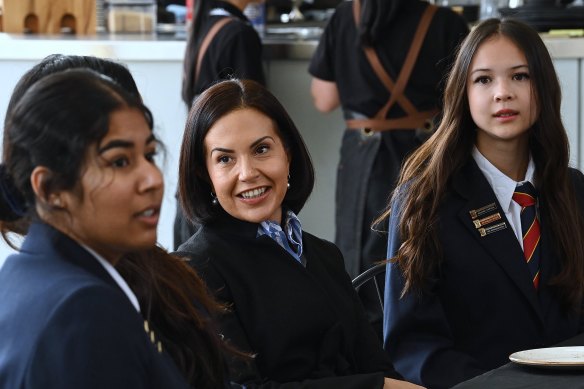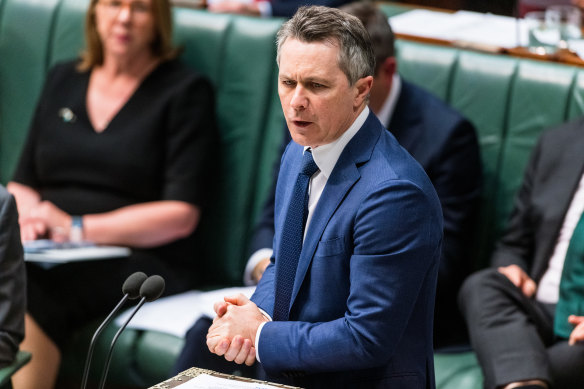By Lucy Carroll and Christopher Harris
NSW public schools face losing billions in extra funding after the state government indicated it would refuse to sign a new agreement that ties additional cash to a raft of education reforms.
Federal Education Minister Jason Clare has given the states until the end of September to accept a new school funding deal or risk losing an extra $16 billion over 10 years, a move that has intensified the stand-off between the Albanese government and state education ministers.

The federal government has given states a deadline of the end of September to indicate if they will sign the next Better and Fairer Schools Agreement.Credit: Kate Geraghty
The next Better and Fairer Schools Agreement ties the bonus Commonwealth funding to targets and reforms including reading and maths screening tests for all year 1 students and reducing the number of students failing to achieve the minimum NAPLAN standards.
NSW previously rejected Clare’s offer to lift the federal share of funding to public schools by 2.5 per cent – which would pump an extra $4.1 billion into the state’s public schools over the next decade – instead calling for a 5 per cent boost.
NSW Education Minister Prue Car on Wednesday repeated her demand that the Commonwealth double its offer, saying the state would not sign up to an agreement “that doesn’t benefit public school students of NSW”.
“We have made this very clear. The Commonwealth has deeper pockets when it comes to the opportunity for funding NSW public schools,” Car said.
“The vast majority of states and territories are in lockstep with NSW, saying we need increased funding in NSW. We need the Commonwealth government to come to the table with a bigger share of funding so we can make sure that at the starting line our kids have a fairer go at it.
“We are not signing up to an arrangement that doesn’t bring benefit to the kids of NSW. If the offer on the table means signing up to a raft of new responsibilities and reporting without a commensurate funding then we don’t need until September to say no.”
Clare’s offer would raise the Commonwealth’s long-standing share of funding for public schools to 22.5 per cent, an increase worth $16.12 billion across the decade. On Wednesday, the Northern Territory became the first jurisdiction to sign the deal, while Western Australia is expected to sign within days.
Under the current agreements, the states provide the bulk of public school funding, 80 per cent to the federal government’s 20 per cent.
The new agreement outlines multiple reforms tied to the funding boost including lifting the proportion of students finishing year 12 from 76.3 per cent to 83.8 per cent by 2030 and increasing attendance rates.

The next school reform agreement includes multiple reforms including a year 1 phonics check and a primary school numeracy check.Credit: James Brickwood
It sets out targets for reducing the proportion of children in the “needing additional support” NAPLAN level for reading and numeracy by 10 per cent, and boosting those in the top two proficiency levels by 2030.
About one-third of NSW students scored in the bottom two bands in this year’s literacy and numeracy results, while 8 per cent failed to read and write at the basic level expected for their age.
The deal also requires all year 1 students to take a phonics check to test reading skills and a primary school numeracy check to catch students at risk of falling behind.
New reporting and transparency requirements around how taxpayer money is spent are also included, with a new public reporting dashboard to outline how much funding each jurisdiction is investing in the reforms.
Clare said the additional $16 billion of funding for public schools would be tied to reforms “that will help kids catch up, keep up and finish school”.
“Practical things like phonics checks and numeracy checks, evidenced-based teaching and catch-up tutoring, to identify kids who need additional support and make sure they get it.”
The stalemate over the deal was criticised by public education advocate Trevor Cobbold who said the “disgraceful squabbling over cost-shifting by governments” was threatening the education of millions of students.
“It is now 12 years since the Gonski Report identified the need to boost funding for public schools to improve equity in school outcomes. The shameful failure of governments to fully fund public schools cannot continue any longer,” he said.
Federal Liberal education spokesperson Sarah Henderson labelled the stand-off an “embarrassing policy failure” by the Albanese government.
Before the last NSW election, Labor said it was prepared to top up shortfalls to reach full funding if no agreement could be made with the federal government.
NSW opposition education spokeswoman Sarah Mitchell said the former state government’s position was that the federal government should fund the remaining 5 per cent gap.
“What concerns me is we are seeing a complete backflip from Prue Car and Labor. Before the election, [the minister] said that their government would meet the funding shortfall if the Commonwealth didn’t stump up the extra cash,” Mitchell said.
Start the day with a summary of the day’s most important and interesting stories, analysis and insights. Sign up for our Morning Edition newsletter.